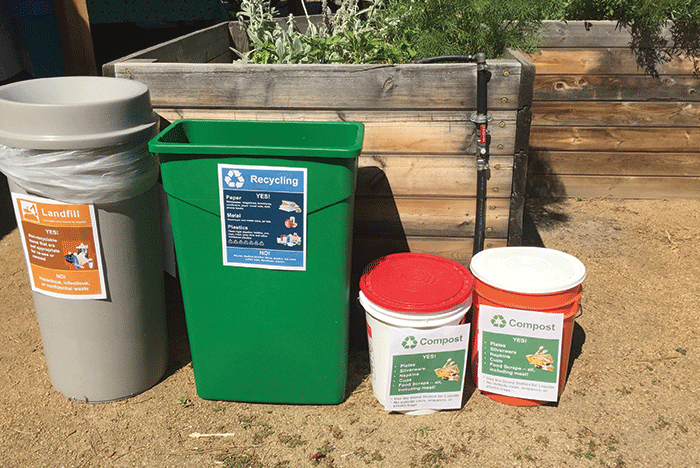Nurse Climate Champions lead hospital sustainability changes

Providence St. Patrick Hospital stations clearly marked waste separation bins in its garden.
Image courtesy of Providence St. Patrick Hospital
Climate change has been linked to numerous health hazards, from respiratory disease to water-borne illnesses to mental health concerns. While health facilities work to treat the effects of climate change on human health, they are also faced with the task of reducing their own environmental impact.
In this effort, nurses have emerged as a uniquely influential group. With some of the most patient-facing roles in health care, nurses not only see the effects of climate change on human health firsthand, but they also can be a positive influence in mitigating them.
This is the idea behind the Nurses Climate Challenge, the result of a partnership between Health Care Without Harm and the Alliance of Nurses for Healthy Environments. This campaign aims to encourage a team of “Nurse Climate Champions” across the United States to educate a total of 50,000 health professionals by 2022 on the effects of climate change on human health. Launched in spring 2018, it is the first nationwide campaign to specifically encourage nurses to motivate their colleagues against climate change. As of press time, the program has documented 13,726 participants.
Health care has a vital role to play in combating climate change, since the field contributes to 10% of greenhouse gases in the United States, says Beth Schenk, Ph.D., sustainability coordinator at Providence St. Patrick Hospital in Missoula, Mont., citing a 2016 study.
“It’s always a balance between efficiency and expense,” says Schenk, a Nurse Climate Champion and member of the Alliance of Nurses for Healthy Environments.
At St. Patrick, which is part of Providence Health & Services, the Nurses Climate Challenge has educated more than 450 nurses at the hospital so far. The hospital has also been able to incorporate the challenge into its existing sustainability programs. Schenk notes that turnover among health care staff means that climate change education is an ongoing opportunity in most facilities.
Reducing waste is a high priority among St. Patrick’s sustainability efforts, Schenk says. The hospital’s recycling initiatives include the creation a wide-reaching program that not only focuses on recycling waste, but also donating unusable items such as fabrics, furnishings, clinical supplies and food. This has helped the hospital educate the community, earn national recognition and reduce costs by as much as $1 million annually.
It also continues to grow its food waste reduction program. In 2014, the hospital built a garden that has been used for education, staff respite and growing food for local food banks. Partnering with a local vendor, the hospital also launched composting efforts in 2017, starting with food preparation scraps and leftovers from special events. St. Patrick hopes to start composting from its hospital food trays in 2020.
“We have been able to conduct several studies on waste reduction, linen reduction, staff awareness and education,” Schenk says. “This is another great way to engage staff and advance knowledge.”
Reducing waste is just one of many causes nurses are championing in their hospitals. Colleen Groll, Nurse Climate Champion and sustainability manager at Seattle Children’s Hospital, has been an advocate of greening the hospital’s supply chain as she works to reduce procurement of products that use potentially harmful chemicals.
The hospital has reduced furnishings that incorporate antimicrobials, flame retardants and formaldehyde in their products. By doing so, the hospital hopes to encourage manufacturers to use more environmentally friendly alternatives in their products.
“We have to mitigate our own carbon footprint, but then we also have to provide leadership in health care,” Groll explains. “Sometimes that’s educating patients and families, and sometimes that’s just turning out the light in the office. The engagement can take on different forms.”




